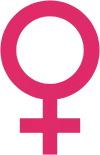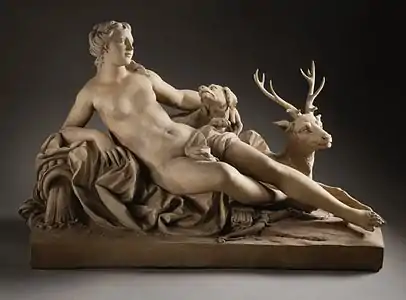Dianic Wicca
Dianic Wicca, also known as Dianic Witchcraft,[1] is a neopagan religion female-centered goddess ritual and tradition. While some adherents identify as Wiccan, it differs from most traditions of Wicca in that only goddesses are honored (whereas most Wiccan traditions honor both female and male deities).[2][3]
| Part of a series on |
| Feminism |
|---|
 |
|
|
| Dianic Wicca | |
|---|---|
 | |
| Abbreviation | DW |
| Type | Wicca |
| Orientation | Feminist orientated Wicca |
| Theology | Goddess movement |
| Governance | Female-orientation Priesthood |
| Region | United States |
| Founder | Zsuzsanna Budapest |
| Origin | 1970s United States |
| Members | Around 1,000-2,000 |
While there is more than one tradition that calls itself Dianic,[3] the best known is the female-only variety,[1] founded by Zsuzsanna Budapest in the United States in the 1970s.[2][3] It is notable for its worship of a single Goddess and focus on egalitarian matriarchy. It is named after the Roman goddess Diana, but Dianics worship goddesses from many cultures, seeing them as "aspects" of a monotheistic goddess.[2] Dianic Wicca is an eclectic combination of elements from British Traditional Wicca, Italian folk-magic as recorded by Charles Leland in Aradia, the importance of womanhood, folk magic and healing practices from a variety of different cultures.[2][3]
Beliefs and practices

Dianic Wiccans of the Budapest lineage worship the Goddess, who they see as containing all goddesses, from all cultures; she is seen as the source of all living things and containing all that is within her.[2] Dianic covens practice magic in the form of meditation and visualization in addition to spell work. They focus especially on healing themselves from the wounds of the patriarchy while affirming their own womanhood.
Rituals can include reenacting religious and spiritual lore from a female-centered standpoint, celebrating the female body, and mourning society's abuses of women.[5] The practice of magic is rooted in the belief that energy or 'life force' can be directed to enact change.[6] However it is important to note that rituals are often improvised to suit individual or group needs and vary from coven to coven.[7] Some Dianic Wiccans eschew manipulative spellwork and hexing because it goes against the Wiccan Rede. However, many other Dianic witches (notably Budapest) do not consider hexing or binding of those who attack women to be wrong, and actively encourage the binding of rapists.[2]
Differences from mainstream Wicca
Like other Wiccans, Dianics may form covens, attend festivals, celebrate the eight major Wiccan holidays, and gather on Esbats.[2] They use many of the same altar tools, rituals, and vocabulary as other Wiccans. Dianics may also gather in less formal Circles.[8] The most noticeable difference between the two are that Dianic covens of Budapest lineage are composed entirely of women.[2][3]
When asked why "men and gods" are excluded from her rituals, Budapest stated:
It's the natural law, as women fare so fares the world, their children, and that's everybody. If you lift up the women you have lifted up humanity. Men have to learn to develop their own mysteries. Where is the order of Attis? Pan? Zagreus? Not only research it, but then popularize it as well as I have done. Where are the Dionysian rites? I think men are lazy in this aspect by not working this up for themselves. It's their own task, not ours.
— during a 2007 interview[8]
There is therapeutic value inherent in Dianic ritual—many women use it to overcome personal trauma and raise awareness about violence towards women, earning comparisons to female-centered consciousness-raising groups in the 1960s and 70s.[9][10] In fact, some groups develop rituals specifically to confront gendered personal trauma, such as battery, rape, incest, and partner abuse. In one ethnographic study of such a ritual, women shifted their understanding of power from the hands of their abusers to themselves. It was found that this ritual had improved self-perception in participants in the short-term, and that the results could be sustained with ongoing practice.[11][12]
Dianics pride themselves on the inclusion of lesbian and bisexual members. It is a goal within many covens to explore female sexuality and sensuality outside of male control, and many rituals function to affirm lesbian sexuality,[13] making it a popular tradition for women who have come out.[6] Some covens exclusively consist of same-sex oriented women and advocate lesbian separatism.
Dianic Wicca developed from the Women's Liberation Movement and covens traditionally compare themselves with radical feminism. Some of these covens reject transgender people who were assigned male at birth.[13] Some groups also directly challenge gender identity.[10]
History
.png.webp)
Aradia, or the Gospel of the Witches claims that ancient Diana, Aphrodite, Aradia, and Herodius cults linked to the Sacred Mysteries are the origin of the all-female coven and many witch myths as we know them. Dianic Wicca began on the Winter Solstice of 1971, when Budapest led a ceremony in Hollywood, California.[2][3] Self-identifying as a "hereditary witch,"[2][3] and claiming to have learned folk magic from her mother,[2][3] Budapest is frequently considered the mother of modern Dianic Wiccan tradition.[3] Dianic Wicca itself is named after the Roman goddess of the same name.[14]
Denominations and related traditions
- Traditions derived from Zsuzsanna Budapest - Female-only covens run by priestesses trained and initiated by Budapest.
- Independent Dianic witches - who may have been inspired by Budapest, her published work (such as The Holy Book of Women's Mysteries) or other woman's spirituality movements, and who emphasize independent study and self-initiation.
McFarland Dianic
McFarland Dianic is a Neopagan tradition of goddess worship founded by Morgan McFarland and Mark Roberts which, despite the shared name, has a different theology and in some cases accepts male participants.[3] McFarland largely bases their tradition on the work of Robert Graves and his book The White Goddess. While some McFarland covens will initiate men, the leadership is limited to female priestesses. Like other Dianic traditions, "McFarland Dianic covens espouse feminism as an all-important concept." They consider the decision whether to include or exclude males as "solely the choice of [a member coven's] individual High Priestess."[15]
See also
References
- River, Falcon (7 May 2004). "The Dianic Wiccan Tradition". The Witches Voice. Retrieved 23 May 2007. and, to some also as "Dianism," "Dianic Feminist Witchcraft," or simply "Feminist Witchcraft"'
- Budapest, Zsuzsanna. Holy Book of Women's Mysteries, The. 1980 (2003 electronic). ISBN 0-914728-67-9.
- Adler, Margot. Drawing Down the Moon: Witches, Druids, Goddess-Worshippers, and Other Pagans in America Today. Boston: Beacon press, 1979; 1986. ISBN 0-8070-3237-9. Chapter 8: Women, Feminism, and the Craft".
- "Temple of Diana - The Tradition of Dianic Wicca". templeofdiana.org. Archived from the original on 2013-12-06.
- Foltz, Tanice G. (2000). "Women's Spirituality Research: Doing Feminism". Sociology of Religion. 61 (4): 409. doi:10.2307/3712524. ISSN 1069-4404.
- Smith, Brandy and Sharon Horne. "Gay, Lesbian, Bisexual and Transgendered (GLBT) Experiences with Earth-Spirited Faith." The Journal of Homosexuality, 52.3/4 (2007): 235-248.
- Warwick, Lynda L. "Feminist Wicca: Paths to Empowerment." Women & Therapy 16.2-3 (1995): 121.
- Velkoborska, Kamila, Wicca in the USA: How a British-born Religion Became Americanized (PDF), Tomas Bata University, retrieved 25 October 2011
- Foltz, Tanic G. and Wendy Griffin. "Ethnographic Journeys of Self Discovery", Composing Ethnography: Alternative Forms of Qualitative Writing. (1996): 301–330.
- Lozano, Wendy G. and Tanic G. Foltz. "An Ethnographic Study of Witchcraft and Death", Qualitative Sociology, Vol. 13, No. 13. (1990): 211–234.
- Jacobs, Janet L. "The Effects of Ritual Healing on Female Victims of Abuse: A Study of Empowerment and Transformation". Sociological Analysis, 50.3 (1989): 265–279.
- Jacobs, Janet L. "Women, Ritual, and Power". Frontiers: A Journal of Women Studies, 11.2–3 (1990): 39–44.
- Barrett, Ruth Rhiannon (2008). "Lesbian Rituals and Dianic Tradition". Journal of Lesbian Studies. 7 (2): 15–28. doi:10.1300/J155v07n02_03. ISSN 1089-4160.
- Oswald, Ramona Faith (2003). Lesbian rites: symbolic acts and the power of community. Bringhampton, New York: Harrington Park Press. pp. 15, 16, 17. ISBN 1-56023-315-X.
- "The McFarland Dianics -- A Chronology - Spring Equinox, 2000". Archived from the original on 27 July 2011.
Further reading
- Barrett, Ruth. Women's Rites, Women's Mysteries: Intuitive Ritual Creation. Llewellyn Publications; 2007, ISBN 0-7387-0924-7. Earlier publishing: Women's Rites, Women's Mysteries: Creating Ritual in the Dianic Wiccan Tradition. Authorhouse; 2004, ISBN 1-4184-8295-1.
- Eisler, Riane, The Chalice and the Blade.
- Mountainwater, Shekhinah, Ariadne's Thread.
- Ochshorn, Judith and Cole, Ellen. Women's Spirituality, Women's Lives. Haworth Press 1995. ISBN 1-56024-722-3. pp 122 & 133 referring to Z Budapest and Shekinah Mountainwater, among others, in a discussion of Dianic Witchcraft.
- Pond, Gina, et al. Gender and Transgender in Modern Paganism. Circle of Cerridwen Press, 2012. ISBN 978-1-105-43378-8
- On Starhawk, the Reclaiming Tradition and feminism, M. Macha NightMare.
- Interview with Starhawk in Modern Pagans: An Investigation of Contemporary Pagan Practices, ed. V. Vale and John Sulak, Re/Search, San Francisco, 2001, ISBN 1-889307-10-6.
External links
- Dianic Wicca, Official Website
- Dianic Tradition, Official Website
- Dianic Wicca, Website
- Z. Budapest
- International Goddess Conference
- Susan B. Anthony Coven, Dianic Wicca Website
- Temple of Diana
- The McFarland Dianic Tradition
